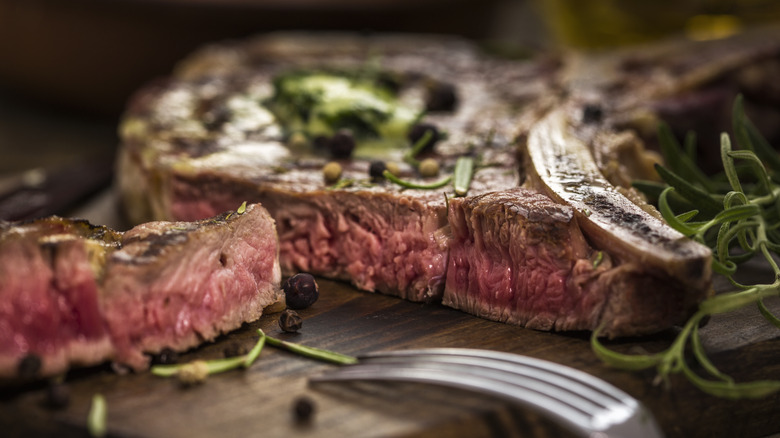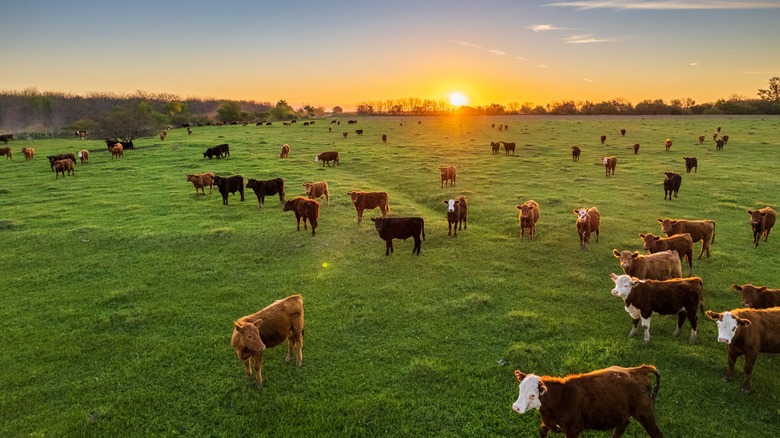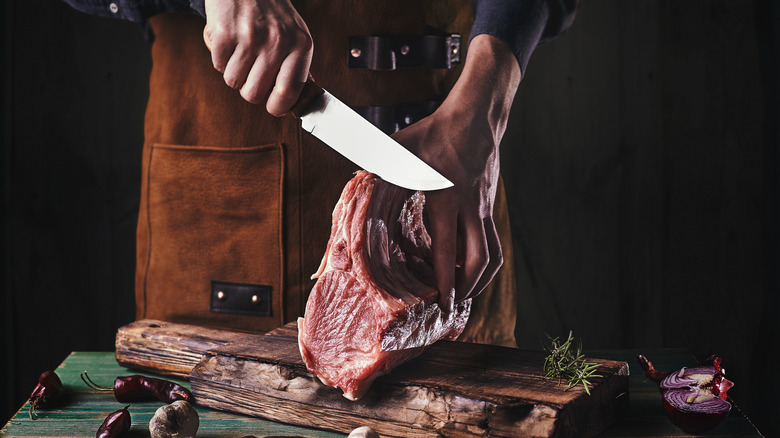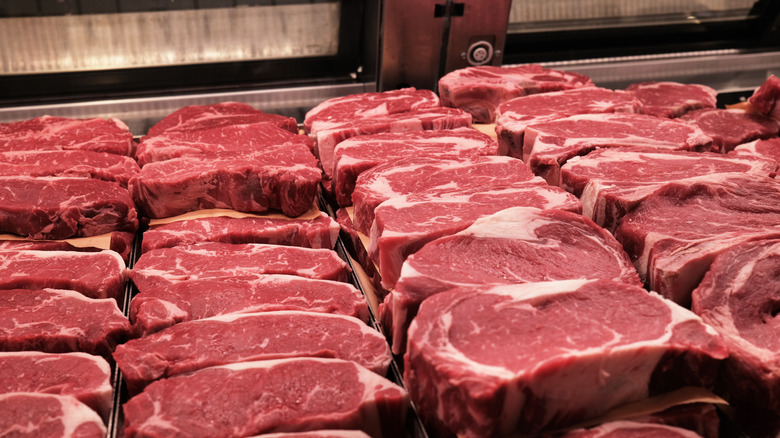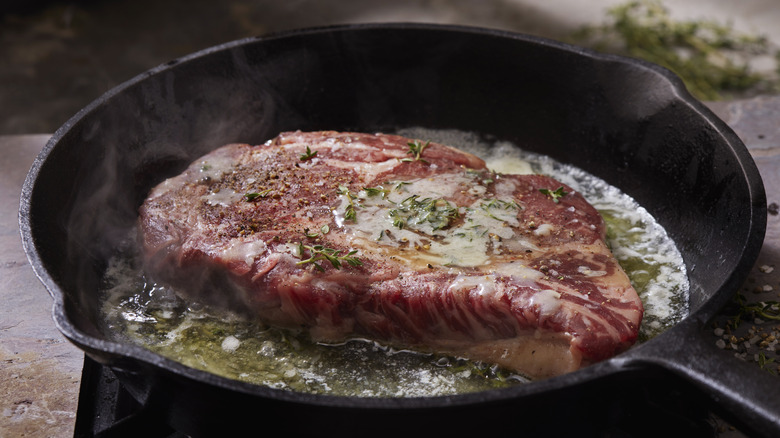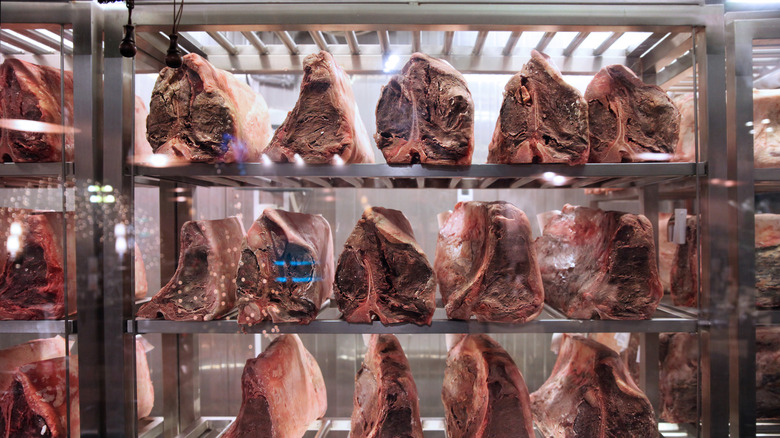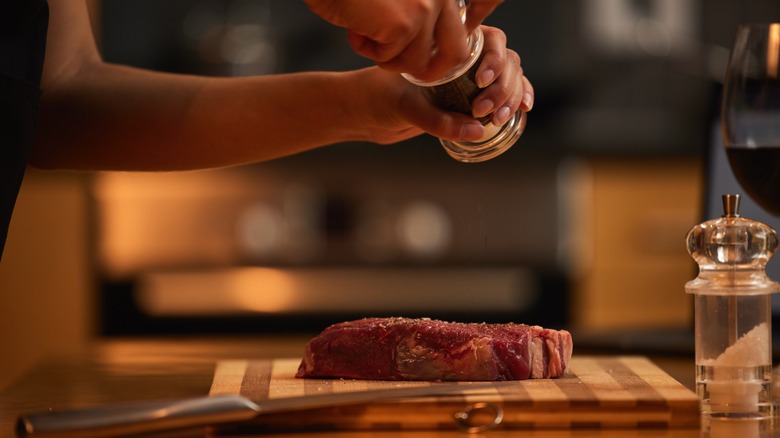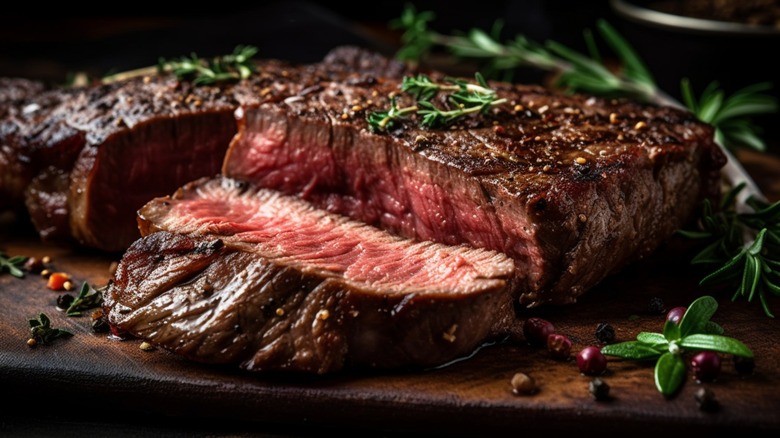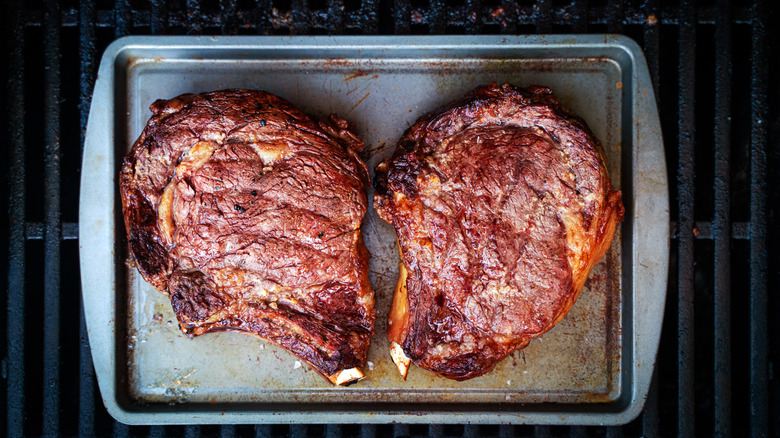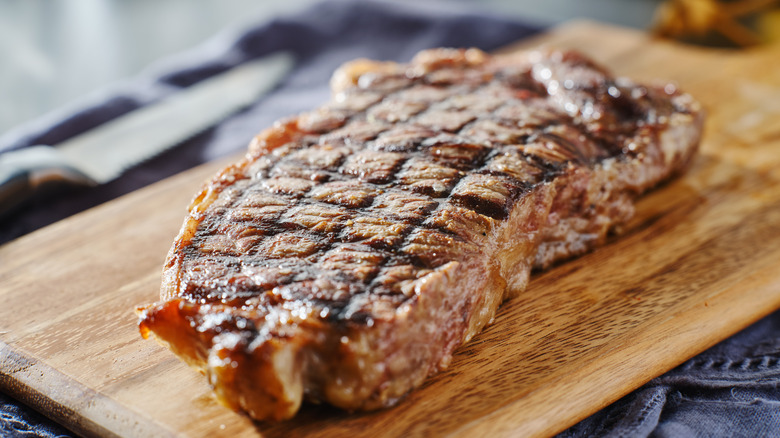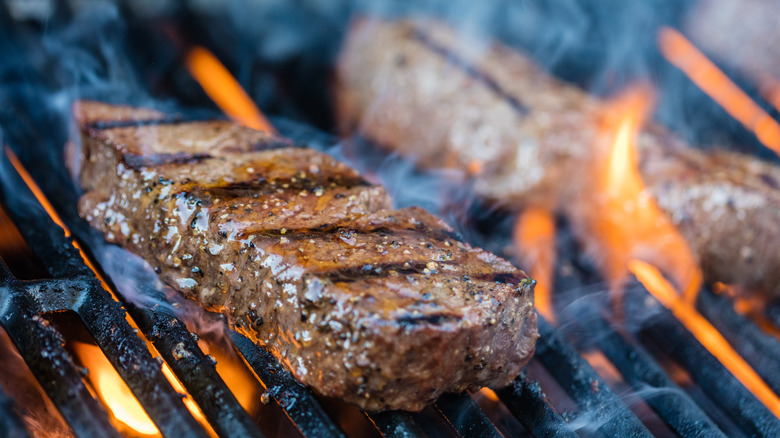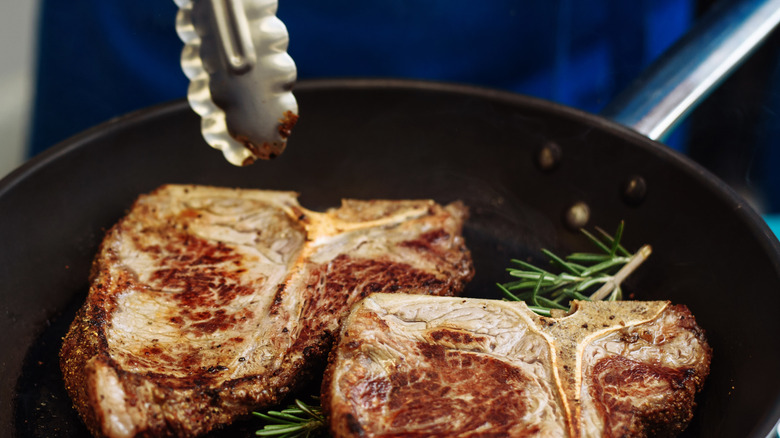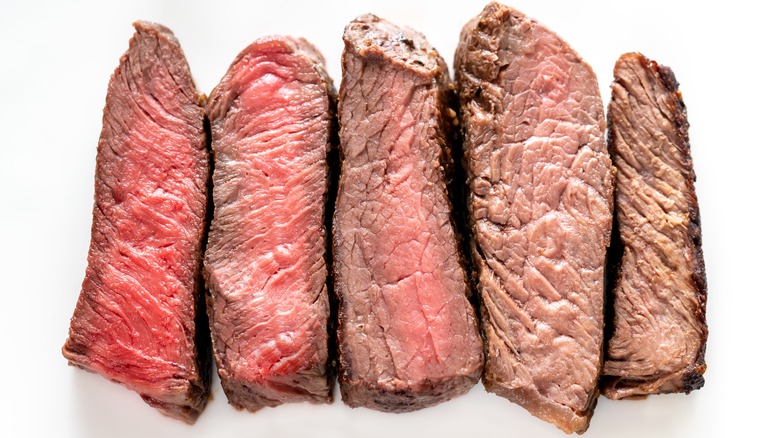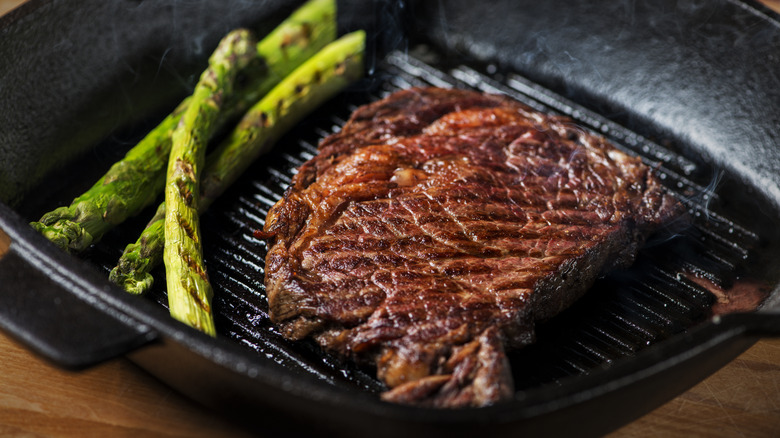Secrets Of Steak Science You'll Wish You Knew Sooner
If you were to ask a home cook what's more scientific, cooking or baking, most would say baking. After all, anyone who's witnessed a baking disaster knows that, oftentimes, baking mishaps come down to some science-based, minute part of the process. Maybe you didn't add enough leavening agent or maybe it was something seemingly even more inconsequential, like the eggs weren't the right temperature when you added them.
However, cooking, though more forgiving than baking, comes with its own science, too. Take steak, for example. Everyone has their own personal take on what makes a good steak, whether that be the level of doneness, cut, or cooking method. Whatever the opinion, though, it all comes down to science. A multitude of factors influence how a steak cooks and then tastes, on a scientific level. Starting with biology, how a cow is raised and its lifestyle will impact your final dining experience. Then, after the cow is turned into steak, you get into chemistry and how the steak changes due to environmental factors. Eventually, when it's time to cook, you get into thermodynamics. Sounds a little complicated? Don't worry; understanding the secrets of steak science is easier than you might think. Here's what you need to know.
A great steak starts with the cow
While it might not always be pleasant to think about, your steak started as a cow which had a life before it made its way to your plate. How that cow lived its life directly impacts what your steak tastes like and its texture. If a cow pasture grazes its entire life, then its body will naturally contain more omega-3 fatty acids. Omega-3 fatty acids have a gamey flavor. According to Murdoch University, how active the cow is (and how old it is) will impact texture, as active muscles build up collagen which is tough to chew. Additionally, added hormones also result in tougher meat, because hormones affect muscle development. When you eat a steak, you're eating that muscle.
All of the above said, though, if you really want to control your steak's flavor and texture starting with the life of the cow, you'll have to do some extra legwork to really find out how the cow lived. According to Max Greb, also known as Max the Meat Guy on social media, where he covers all things cooking with meat, "Beware of labels like 'grass fed,' as grocery stores often fail to disclose the full truth. The cow may have been 'grass-fed' for some of its life, but that doesn't necessarily mean it was grass fed the entirety of its life. Always ask the butcher (or check the label) to make sure the steak is 100% grass-fed and grass-finished."
There is such a thing as a too-fresh steak
If you're a true crime fan, then you know what "rigor mortis" is. However, just like rigor mortis affects a deceased human, it also affects that cow you're going to eat. Because of this, there is such a thing as a "too-fresh" steak. While, when it comes to most food, fresher is better (who doesn't love a summer tomato eaten minutes after it was picked from the vine?), that's not the case with beef cattle.
According to a professor at Murdoch University, just as is the case in humans, about 24 hours after a cow is butchered, rigor mortis occurs. Put very, very simply, rigor mortis is a chemical change in a muscle that stiffens that muscle. A stiff muscle is a tough muscle and not one that's exactly great to eat. It takes a minimum of five days for this stiffening effect to begin to wane.
Picking a good steak is about more than just marbling
You've probably heard the very basic advice regarding picking up a good steak in the grocery store. You're supposed to look for a steak with lots of marbling. More marbling equals a good steak. However, it's a bit more complex than that. Picking a good steak is about more than just marbling. It's about acids and fats, too, and marbling covers both of these.
Marbling is technically fat, as Max Greb told us. He explained that marbling is "the flecks of white intramuscular fat within the steak itself. More marbling equals more flavor and juiciness." Additionally, as Smithsonian Magazine pointed out, some steaks with more marbling also have more acid content, like oleic acid, which is often connected to desirable flavors. A steak with more oleic acid might be a cut that's considered more flavorful, like a ribeye. How much acid, fat, and marbling a steak contains can be traced back to, again, how the cow was raised and lived.
The Maillard reaction is a chemical process that impacts flavor
If you know even one thing about steak science, you probably know about the Maillard reaction. If not, though, Max Greb explained, "If you've ever tasted a steak with a nice char, you know how important that crispy crust is for flavor. This caramelization is achieved through something called the 'Maillard reaction' which only starts to occur past 300 [degrees Fahrenheit]. This is why steamed food can never develop a flavorful 'crust.'"
The Maillard reaction occurs when amino acids and sugars undergo a chemical reaction when they reach a certain temperature. The reaction produces new molecules that are directly responsible for the charred, caramelized flavor that you can enjoy on not only steak, but also on any food that you can brown. It's why a vegetable roasted in the oven tastes a whole lot better than a vegetable boiled in water on the stovetop.
Aging and marinating serve the same function
If you're preparing a steak at home, you might choose to marinate it for a few hours or overnight before cooking. The idea is to create a more flavorful, more tender cut of meat. However, you're likely not going to do any steak aging at home. That sounds a little more complicated, and it might be best left to the pros. That's why you see aged steaks in high-end steakhouses. That said, from a purely scientific standpoint, aging and marinating aren't that different. They serve the same function.
Both marinating and aging call upon chemical processes to tenderize a cut of meat. The processes just differ slightly. In aging, over a short period of time, enzymes, fats, and bacteria begin to change within the meat, breaking down collagen and muscle, which makes for a more tender steak. Marinating does the same work in a shorter time period, using acids. Rather than let the steak do its own thing over several weeks, when you marinate a steak, you add in some extra helpers, like vinegar or fruit juice, to speed up the collagen and muscle breakdown.
You might not need to let your steaks come to room temperature
Yet another piece of advice that you'll hear again and again from well-meaning home cooks? Let your thawed steak sit out on the counter until it comes to room temperature before cooking it. However, some experts say this step is unnecessary. Max Greb said, "[Whether or not to let your steaks come to room temperature] is probably the most controversial steak question there is. While many chefs swear by this, I believe it is not necessary. I've run several tests, going as far as cooking steaks that were still completely frozen, with very minimal difference in results. The bottom line is, it doesn't hurt, but likely won't make a noticeable difference."
One case study, produced by engineer Wei Wang, found that if you take a steak with 75% water content at an average refrigerated temperature while using a typical gas burner, while also noting the heat capacity of both beef and water, all of that data can predict that you can cook a steak from refrigerated to finished (or to an internal temperature of 60 degrees Celsius, or 140 degrees Fahrenheit, so medium rare) in 12 minutes. Cooking another steak from room temp to the same degree of doneness only takes 10 minutes. In other words, you can get the same results from both methods, cooking at room temperature or straight from the fridge, with only a two-minute difference in cooking time.
Temperature impacts your steak's appearance
Beyond how science impacts your steak's flavor and texture, though, it also impacts how your steak appears, which is a matter that differs in importance depending on who you ask. However, if you want a steak that's the same color, all the way through, with no weird lines on the inside, Max Greb explains how to make it happen: by using the reverse searing technique.
He said, "This works particularly well for thicker steaks. Start by slowly letting your steak come up to your target internal temperature in a low-temp oven, smoker, or grill (about 250 degrees Fahrenheit). If using a grill, create a 'hot zone' and a 'cool zone.' To do this, only turn on the burners on one side on a gas grill [or] pour your hot coals on only one side of [a] charcoal grill. Once the steak reaches its target doneness...let it rest for about 10 minutes, then sear [it] over extremely high heat on a grill or cast iron. By cooking with low heat to start, the steak will have a perfect, edge-to-edge pink interior and you will avoid the dreaded 'gray band.'"
The cooking process doesn't end when you take the steaks off the heat
While you might be able to skip letting your steak rest on the countertop before you cook it, there is a time when you might want to let it rest otherwise — after it's finished cooking. This is due to something called "carryover cooking" and it's something you need to pay attention to. This ensures that you don't overcook your steak and that you have the juiciest steak possible.
When you remove a steak from the grill or turn off the burner, it's not like it magically cools to room temperature instantly. It's still holding on to all that heat, so, until that heat dissipates, the steak continues to cook; because of this, you'll want to remove it from heat slightly before the steak's doneness and let it continue to do its thing as it rests. Additionally, while it rests, your steak will also be redistributing its juices. During the cooking process, the water content within the steak pools near the steak's exterior. As the steak cools, that moisture redistributes, for a juicy interior all the way through. So, how long should you let the steak rest? Max Greb advised, "Let thin steaks rest on the cutting board for about 5–7 minutes before slicing, and thicker steaks 10–15 minutes. Resting cooked steaks allows the flavorful juices to redistribute back into the meat, instead of being wasted on the cutting board."
Carryover cooking depends on environmental factors
While you can rely on carryover cooking to always occur, when cooking really anything (unless you're blanching an ingredient, which means boiling it and then placing it in icy water in order to stop the cooking quickly), carryover cooking is not an exact science. Environmental factors impact how and to what degree carryover cooking occurs.
As the aforementioned case study explains, a range of factors will influence how much the internal temperature of your steak rises during carryover cooking, as you allow it to rest. These factors can include the cut of steak, the temperature in the room, the humidity in the room, and airflow. According to ThermoWorks, additional factors that can influence carryover cooking include your food's thermal mass (or its heat capacity), the steak's shape, and surface area. ThermoWorks estimates that on average, carryover cooking raises the internal temperature of your steak by between 3 and 6 degrees Fahrenheit.
Oxidation isn't a bad thing, even though it's not pretty
Have you ever avoided a steak in the grocery store because it had a little gray-brown tint to it? You may have assumed the steak had gone bad. After all, shouldn't raw steaks be bright red? The truth is, you may have passed up a perfectly good steak. That odd hue was mostly likely caused by oxidation and it's nothing to worry about. According to Max Greb, "Don't be afraid of oxidation. Sometimes meat turns slightly grayish. This is only due to the meat being exposed to oxygen. Often, you will find perfectly good steaks at a huge discount due to this discoloration, which has zero impact on taste."
The United States Department of Agriculture agrees, noting that beef stored in a refrigerator or similar environment may experience oxidation. However, if you have beef that's been in extended storage, like in the freezer, vacuum packed, and it turns brown, that could be a sign of spoilage.
The higher the steak's fat content, the easier it is to cook
If you're a newer home cook or just getting your footing around the grill, you may be looking for a steak that's particularly easy to cook. If so, Max Greb said to reach for a steak with a high fat content. He explained, "The fattier the cut, the easier and more foolproof to cook. Let's compare a ribeye, which is rich and fatty, to a filet mignon which is extremely lean. A ribeye tastes great medium rare, but even if you overcook it, the marbling will really help prevent the meat from drying out. On the other hand, a filet mignon is amazing when cooked to rare or medium rare, but if you overcook it by even 30 seconds, it will quickly dry out, and your $30 per pound steak will turn into shoe leather."
Greb also added that there are other great steak cuts if filet or ribeye are too expensive. He suggested, "Steaks like flat iron, Denver, outside skirt steak, hangar, and flap steak are all underrated [and a] great value, and quite foolproof as well."
A steak's muscle fibers and water content impacts when it's best to flip it
There's a fine line you have to walk when it comes to flipping your steak and that line is created by your steak's muscle fibers and water content, as well as the Maillard reaction. On one hand, you don't want to only flip it once, Max Greb said. You don't want to flip it too late in the game, either.
Greb noted, "There is a myth that steaks should 'only be flipped once.' Flipping frequently allows even contact with the heat source and significantly more even cooking. However, it's important to only start flipping once the crust has started to set. Immediately flipping a steak can make the seasoning start to fall off. A good rule of thumb is to let the steak sear for two minutes on both sides, then start flipping every 30 seconds." Home cooks should flip steaks about a third of the way while cooking because the muscle fibers contract and push the water content around the steak as it heats up. Flipping the steak a third of the way into the process (rather than halfway) ensures that the water content doesn't pool on one side of the steak, thus cooling it and requiring a longer cooking time.
Level of doneness isn't just personal preference
Some swear that a rarer steak simply tastes better and that a well-done steak has no flavor at all. In contrast, some say that a well-done steak is superior and that anything that bleeds has no place on their plate. Whatever your preferences, though, they're due to science.
A rare steak hasn't been heated through enough for the fatty acids to break down. As those fatty acids break down while cooking, they create some of the characteristic steak flavors. Once you begin heating the steak a little bit longer, more flavors are produced. However, heat a steak longer than that and some of those flavors dissipate, as compounds break down and emerge. While you likely want to cook your steak long enough that the Maillard reaction takes effect, once that reaction runs its course, burning begins. So, depending on how you order your steak, it could indicate that you prefer the flavors of certain beef compounds.
A seared steak isn't a sealed steak
Another common misconception regarding cooking steaks? If you've seared a steak, you've essentially sealed it, preventing any moisture from leaking out, at least until you pierce the steak's exterior. However, this isn't the case. Rather, it's more likely that you just think you've sealed the steak by searing because you're cooking the steak at such a high temperature that any moisture that leaks out is sizzling and evaporating quickly.
As The Exploratorium covered, when you examine a raw versus seared steak under a microscope, it's clear that moisture can pass through the steak's exterior just as easily after the steak's been seared as it can when the steak is raw. When you listen to a steak sizzle, that's water coming out of the steak and immediately evaporating. When you remove the steak from the heat and put it on a plate, that liquid will then pool on the plate, whether or not the steak is seared. This is because the high heat has been removed, and there's nothing to make the liquid evaporate. So, don't worry about searing a steak in order to seal in the juices. Instead, just rely on searing for flavor.
